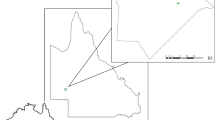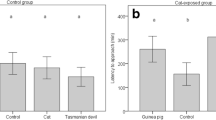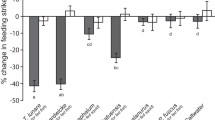Abstract
The “life-dinner principle” posits that there is greater selection pressure on the species that have more to lose in an interaction. Thus, based on the asymmetry within predator-prey interactions, there is an advantage for prey to learn quickly, especially in response to novel, introduced predators. Here, we test the “learned recognition” hypothesis that posits that naïve prey species’ ability to recognise and respond to introduced predators can be induced through experience. We quantified the behavioural response of initially predator-naïve burrowing bettongs (Bettongia lesueur) that had been living in the presence (for 8–15 months) and absence of an introduced predator (feral cats—Felis catus) to models of cats, a herbivore (rabbit (Oryctolagus cuniculus)), novel object (plastic bucket) and no object (control). We expected that if bettongs recognised cats as a threat, they would be more wary in the presence of cat models than either rabbit models, buckets or the control. Bettongs living without predators did not modify their behaviour in response to the cat model, but spent more time cautiously approaching the rabbit model compared with the control. However, bettongs living with cats spent more time cautiously approaching the cat model compared with the rabbit, bucket and control. Our results are consistent with the learned recognition hypothesis which suggests that a predator-naïve prey species ability to recognise novel predators is inducible through experience. Our finding suggests that antipredator responses of reintroduced species could be improved prior to release by exposing them to predators under carefully controlled conditions.
Significance statement
Predator-prey interactions have played a strong selective factor in the evolution of predator avoidance behaviour by prey. In order for prey to appropriately and successfully respond and avoid predation, it is essential that prey species recognise a predatory threat in the first place. The isolation of prey species on predator free islands, geographically isolated continents (such as Australia) and predator-free fenced reserves, means that prey are increasingly isolated from predator-driven natural selection processes. We studied the behavioural response of a population of initially predator-naïve burrowing bettongs that had been living in the presence (for 8–15 months) and absence of feral cats, (an introduced predator). Our results show that predator-naïve prey species’ ability to recognise novel predators is inducible through experience.




Similar content being viewed by others
Data availability
Supplemental data for this article can be accessed at https://orcid.org/0000-0002-9483-2515.
References
Allen B, Fleming P (2012) Reintroducing the dingo: the risk of dingo predation to threatened vertebrates of western New South Wales. Wildl Res 39:35–50. https://doi.org/10.1071/WR11128
Anson JR, Dickman CR (2013) Behavioral responses of native prey to disparate predators: naiveté and predator recognition. Oecologia 171:367–377. https://doi.org/10.1007/s00442-012-2424-7
Apfelbach R, Blanchard CD, Blanchard RJ, Hayes RA, McGregor IS (2005) The effects of predator odors in mammalian prey species: a review of field and laboratory studies. Neurosci Biobehav Rev 29:1123–1144. https://doi.org/10.1016/j.neubiorev.2005.05.005
Arrese C (2002) Pupillary mobility in four species of marsupials with differing lifestyles. J Zool 256:191–197. https://doi.org/10.1017/S0952836902000225
Atkins R, Blumstein DT, Moseby KE, West R, Hyatt M, Letnic M (2016) Deep evolutionary experience explains mammalian responses to predators. Behav Ecol Sociobiol 70:1755–1763. https://doi.org/10.1007/s00265-016-2181-4
Banks P, Hughes N, Rose T (2002) Do native Australian small mammals avoid faeces of domestic dogs? Responses of Rattus fuscipes and Antechinus stuartii. Aust J Zool 32:406–409. https://doi.org/10.7882/AZ.2002.018
Bearder SK, Nekaris KAI, Curtis DJ (2006) A re-evaluation of the role of vision in the activity and communication of nocturnal primates. Folia Primatol 77:50–71. https://doi.org/10.1159/000089695
Beauchamp G (2004) Reduced flocking by birds on islands with relaxed predation. Proc R Soc Lond B 271:1039–1042. https://doi.org/10.1098/rspb.2004.2703
Beauchamp G (2015) In: New York (ed) Animal vigilance: monitoring predators and competitors, Academic Press
Bednekoff PA, Lima SL (1998) Randomness, chaos and confusion in the study of antipredator vigilance. Trends Ecol Evol 13:284–287. https://doi.org/10.1016/S0169-5347(98)01327-5
Berger J, Swenson JE, Persson IL (2001) Recolonizing carnivores and naïve prey: conservation lessons from Pleistocene extinctions. Science 291:1036–1039. https://doi.org/10.1126/science.1056466
Berger J, Terborgh J, Estes J (2010) Fear-mediated food webs. In: Terborgh J, Estes JA (eds) Trophic cascades: predators, prey, and the changing dynamics of nature. Island Press, Washington, pp 241–253
Blumstein DT, Daniel JC (2005) The loss of anti-predator behaviour following isolation on islands. Proc R Soc Lond B 272:1663–1668. https://doi.org/10.1098/rspb.2005.3147
Blumstein DT, Daniel JC (2007) Quantifying behaviour the JWatcher Way. Sinauer Associates Inc, Sunderland
Blumstein DT, Daniel JC, Griffin AS, Evans CS (2000) Insular tammar wallabies (Macropus eugenii) respond to visual but not acoustic cues from predators. Behav Ecol 11:528–535. https://doi.org/10.1093/beheco/11.5.528
Blumstein DT, Daniel JC, Schnell MR, Ardron JG, Evans CS (2002) Antipredator behaviour of red-necked pademelons: a factor contributing to species survival? Anim Conserv 5:325–331. https://doi.org/10.1017/S1367943002004080
Bøving PS, Post E (1997) Vigilance and foraging behaviour of female caribou in relation to predation risk. Rangifer 17:55–63. https://doi.org/10.7557/2.17.2.1302
Bradshaw JWS (2006) The evolutionary basis for the feeding behavior of domestic dogs (Canis familiaris) and cats (Felis catus). Nutr J 136:1927S–1931S. https://doi.org/10.1093/jn/136.7.1927S
Brodie EI, Brodie EJ (1999) Predator-prey arms races: asymmetrical selection on predators and prey may be reduced when prey are dangerous. BioScience 49:557–568. https://doi.org/10.2307/1313476
Brown GE, Chivers DP (2005) Learning as an adaptive response to predation. In: Barbosa P, Castellanos I (eds) Ecology of predator/prey interactions. Oxford University Press, Oxford, pp 34–54
Brown GE, Rive AC, Ferrari MCO, Chivers DP (2006) The dynamic nature of antipredator behavior: prey fish integrate threat-sensitive antipredator responses within background levels of predation risk. Behav Ecol Sociobiol 61:9–16. https://doi.org/10.1007/s00265-006-0232-y
Bytheway JP, Banks PB (2019) Overcoming prey naiveté: free-living marsupials develop recognition and effective behavioral responses to alien predators in Australia. Glob Chang Biol 25:1685–1695. https://doi.org/10.1111/gcb14607
Bytheway JP, Price CJ, Banks PB (2016) Deadly intentions: naïve introduced foxes show rapid attraction to odour cues of an unfamiliar native prey. Sci Rep 6:30078. https://doi.org/10.1038/srep30078
Carrete M, Tella JL (2015) Rapid loss of antipredatory behaviour in captive-bred birds is linked to current avian invasions. Sci Rep 5:18274. https://doi.org/10.1038/srep18274
Carthey AJ, Banks PB (2012) When does an alien become a native species? A vulnerable native mammal recognizes and responds to its long-term alien predator. PLoS One 7:e31804. https://doi.org/10.1371/journal.pone.0031804
Carthey AJ, Banks PB (2014) Naïveté in novel ecological interactions: lessons from theory and experimental evidence. Biol Rev 89:932–949. https://doi.org/10.1111/brv.12087
Carthey AJ, Banks PB (2016) Naiveté is not forever: responses of a vulnerable native rodent to its long term alien predators. Oikos 125:918–926. https://doi.org/10.1111/oik.02723
Chivers DP, Smith RJF (1994) Fathead minnows, Pimephales promelas, acquire predator recognition when alarm substance is associated with the sight of unfamiliar fish. Anim Behav 48:597–605. https://doi.org/10.1006/anbe.1994.1279
Chivers DP, Mirza RS, Bryer PJ, Kiesecker JM (2001) Threat-sensitive predator avoidance by slimy sculpins: understanding the importance of visual versus chemical information. Can J Zool 79:867–873. https://doi.org/10.1139/z01-049
Cooper WE, Pyron RA, Garland T (2014) Island tameness: living on islands reduces flight initiation distance. Proc R Soc B Sci 281:20133019. https://doi.org/10.1098/rspb.2013.3019
Corbett LK, Newsome AE (1987) The feeding ecology of the dingo. Oecologia 74:215–227. https://doi.org/10.1007/bf00379362
Coss RG, Goldthwaite RO (1995) The persistence of old designs for perception. In: Thompson NS (ed) Perspectives in ethology: behavioral design, vol 11. Plenum Press, New York, pp 83–148
Cox JG, Lima SL (2006) Naiveté and an aquatic–terrestrial dichotomy in the effects of introduced predators. Trends Ecol Evol 21:674–680. https://doi.org/10.1016/j.tree.2006.07.011
Curio E (1993) Proximate and developmental aspects of antipredator behavior. Adv Study Behav 22:135–238
Dawkins R, Krebs JR (1979) Arms races between and within species. Proc R Soc Lond B 205:489–511
Engbring J, Fritts TH (1988) Demise of an insular avifauna: the brown tree snake on Guam. Trans West Sect Wildl Soc 24:31–37
Epp KJ, Gabor CR (2008) Innate and learned predator recognition mediated by chemical signals in Eurycea nana. Ethology 114:607–615. https://doi.org/10.1111/j.1439-0310.2008.01494.x
Evans CS, Macedonia JM, Marler P (1993) Effects of apparent size and speed on the response of chickens, Gallus gallus, to computer-generated simulations of aerial predators. Anim Behav 46:1–11. https://doi.org/10.1006/anbe.1993.1156
Ferrari MCO (2014) Short-term environmental variation in predation risk leads to differential performance in predation-related cognitive function. Anim Behav 95:9–14. https://doi.org/10.1016/j.anbehav.2014.06.001
Ferrari MCO, Trowell JJ, Brown GE, Chivers DP (2005) The role of learning in the development of threat-sensitive predator avoidance by fathead minnows. Anim Behav 70:777–784. https://doi.org/10.1016/j.anbehav.2005.01.009
Ferrari MCO, Messier F, Chivers DP (2006) The nose knows: minnows determine predator proximity and density through detection of predator odours. Anim Behav 72:927–932. https://doi.org/10.1016/j.anbehav.2006.03.001
Ferrari MCO, Wisenden BD, Chivers DP (2010) Chemical ecology of predator-prey interactions in aquatic ecosystems: a review and prospectus. Can J Zool 88:698–724. https://doi.org/10.1139/Z10-029
Griffin AS, Evans CS (2003) Social learning of antipredator behaviour in a marsupial. Anim Behav 66:485–492. https://doi.org/10.1006/anbe.2003.2207
Griffin AS, Blumstein DT, Evans CS (2000) Training captive-bred or translocated animals to avoid predators. Conserv Biol 14:1317–1326. https://doi.org/10.1046/j.1523-1739.2000.99326.x
Griffin AS, Evans CS, Blumstein DT (2001) Learning specificity in acquired predator recognition. Anim Behav 62:577–589. https://doi.org/10.1006/anbe.2001.178
Heesy CP, Hall MI (2010) The nocturnal bottleneck and the evolution of mammalian vision. Brain, Behav Evol 75:195–203. https://doi.org/10.1159/000314278
Holmes TH, McCormick MI (2010) Smell, learn and live: the role of chemical alarm cues in predator learning during early life history in a marine fish. Behav Process 83:299–305. https://doi.org/10.1016/j.beproc.2010.01.013
Hurlbert SH (1984) Pseudoreplication and the design of ecological field experiments. Ecol Monogr 54:187–211
Johnson C (2006) Australia’s mammal extinctions: a 50,000 year history. Cambridge University Press, Port Melbourne
Kavaliers M, Choleris E, Colwell D (2001) Learning from others to cope with biting flies: social learning of fear-induced conditioned analgesia and active avoidance. Behav Neurosci 115:661–674. https://doi.org/10.1037//0735-7044.115.3.661
Lima SL, Steury T (2005) Perception of predation risk: the foundation of nonlethal predator-prey interactions. In: Barbosa P, Castellanos I (eds) Ecology of predator-prey interactions. Oxford University Press, Oxford, pp 166–188
Maloney RF, McLean IG (1995) Historical and experimental learned predator recognition in free-living New-Zealand robins. Anim Behav 50:1193–1201. https://doi.org/10.1016/0003-3472(95)80036-0
Martin CW (2014) Naive prey exhibit reduced antipredator behavior and survivorship. PeerJ 2:e665. https://doi.org/10.7717/peerj.665
Mascalzoni E, Regolin L (2011) Animal visual perception. Wiley Interdiscip Rev: Cogn Sci 2:106–116. https://doi.org/10.1002/wcs.97
Mazzamuto MV, Cremonesi G, Santicchia F, Preatoni D, Martinoli A, Wauters LA (2018) Rodents in the arena: a critical evaluation of methods measuring personality traits. Ethol Ecol Evo 31:38–58. https://doi.org/10.1080/03949370.2018.1488768
McArthur C, Banks PB, Boonstra R, Forbey JS (2014) The dilemma of foraging herbivores: dealing with food and fear. Oecologia 176:677–689. https://doi.org/10.1007/s00442-014-3076-6
McCormick M, Holmes T (2006) Prey experience of predation influences mortality rates at settlement in a coral reef fish, Pomacentrus amboinensis. J Fish Biol 68:969–974. https://doi.org/10.1111/j.0022-1112.2006.00982.x
McLean IG, Lundie-Jenkins G, Jarman PJ (1996) Teaching an endangered mammal to recognise predators. Biol Conserv 75:51–62. https://doi.org/10.1016/0006-3207(95)00038-0
Mineka S, Cook M (1988) Social learning and the acquisition of snake fear in monkeys. In: Zentall TR, Galef EG Jr (eds) Social learning: psychological and biological perspectives. Erlbaum, Hilldale, pp 51–73
Mirza RS, Ferrari MCO, Kiesecker JM, Chivers DP (2006) Responses of American toad tadpoles to predation cues: behavioural response thresholds, threat-sensitivity and acquired predation recognition. Behaviour 143:877–889. https://doi.org/10.1163/156853906778017926
Moseby KE, Read JL, Paton DC, Copley P, Hill BM, Crisp HA (2011) Predation determines the outcome of 10 reintroduction attempts in arid South Australia. Biol Conserv 144:2863–2872. https://doi.org/10.1016/j.biocon.2011.08.003
Moseby KE, Cameron A, Crisp HA (2012) Can predator avoidance training improve reintroduction outcomes for the greater bilby in arid Australia? Anim Behav 83:1011–1021. https://doi.org/10.1016/j.anbehav.2012.01.023
Moseby KE, Blumstein DT, Letnic M (2016) Harnessing natural selection to tackle the problem of prey naïveté. Evol Appl 9:334–343. https://doi.org/10.1111/eva.12332
Moseby KE, Lollback GW, Lynch CE (2018) Too much of a good thing; successful reintroduction leads to overpopulation in a threatened mammal. Biol Conserv 219:78–88. https://doi.org/10.1016/j.biocon.2018.01.006
Parsons MH, Blumstein BT (2010) Familiarity breeds contempt: kangaroos persistently avoid areas with experimentally deployed dingo scents. PLoS One 5:e10403. https://doi.org/10.1371/journal.pone.0010403
Partan SR, Larco CP, Owens MJ (2009) Wild tree squirrels respond with multisensory enhancement to conspecific robot alarm behaviour. Anim Behav 77:1127–1135. https://doi.org/10.1016/j.anbehav.2008.12.029
Phillips BL, Shine R (2006) An invasive species induces rapid adaptive change in a native predator: cane toads and black snakes in Australia. Proc R Soc Lond B 273:1545–1550. https://doi.org/10.1098/rspb.2006.3479
Quinn GP, Keough MJ (2002) Experimental design and data analysis for biologists. Cambridge, U.K.: Cambridge University Press.
Richards J, Morris K, Burbidge A (2008) Bettongia lesueur. The IUCN Red List of Threatened Species https://doi.org/10.2305/IUCN.UK.2008.RLTS.T2784A9480530.en
Sander U, Short J, Turner B (1997) Social organisation and warren use of the burrowing bettong, Bettongia lesueur (Macropodoidea: Potoroidae). Wildl Res 24:143–157. https://doi.org/10.1071/WR96021
Short J, Turner B (1993) The distribution and abundance of the burrowing bettong (Marsupialia: Macropoidea). Wildl Res 20:525–533. https://doi.org/10.1071/WR9930525
Short J, Turner B (1999) Ecology of burrowing bettongs, Bettongia lesueur (Marsupialia: Potoroidae), on Dorre and Bernier Islands, Western Australia. Wildl Res 26:651–669. https://doi.org/10.1071/WR98039
Short J, Turner B (2000) Reintroduction of the burrowing bettong Bettongia lesueur (Marsupialia: Potoroidae) to mainland Australia. Biol Conserv 96:185–196. https://doi.org/10.1016/S0006-3207(00)00067-7
Steindler LA, Blumstein DT, West R, Moseby KE, Letnic M (2018) Discrimination of introduced predators by ontogenetically naïve prey scales with duration of shared evolutionary history. Anim Behav 137:133–139. https://doi.org/10.1016/j.anbehav.2018.01.013
Turner AM, Turner SE, Lappi HM (2006) Learning, memory and predator avoidance by freshwater snails: effects of experience on predator recognition and defensive strategy. Anim Behav 72:1443–1450. https://doi.org/10.1016/j.anbehav.2006.05.010
van Damme R, Castilla AM (1996) Chemosensory predator recognition in the lizard Podarcis hispanica: effects of predation pressure relaxation. J Chem Ecol 22:13–22. https://doi.org/10.1007/BF02040196
Veen T, Richardson DS, Blaakmeer K, Komdeur J (2000) Experimental evidence for innate predator recognition in the Seychelles warbler. Proc R Soc Lond B 267:2253–2258. https://doi.org/10.1098/rspb.2000.1276
Webb JK, Brown GP, Child T, Greenlees MJ, Phillips BL, Shine R (2008) A native dasyurid predator (common planigale, Planigale maculata) rapidly learns to avoid a toxic invader. Austral Ecol 33:821–829. https://doi.org/10.1111/j.1442-9993.2008.01847.x
West R, Letnic M, Blumstein DT, Moseby KE (2017) Predator exposure improves anti-predator responses in a threatened mammal. J Appl Ecol 55:147–156
Yorzinski JL, Platt ML (2012) The difference between night and day: antipredator behavior in birds. J Ethol 30:211–218. https://doi.org/10.1007/s10164-011-0318-5
Wynne CDL, McLean IG (1999) The comparative psychology of marsupials. Aus J Psychol 51:111–116. https://doi.org/10.1080/00049539908255344
Woinarski JC, Burbidge AA, Harrison PL (2015) Ongoing unraveling of a continental fauna: decline and extinction of Australian mammals since European settlement. P Natl Acad Sci USA 112:4531–4540. https://doi.org/10.1073/pnas.1417301112
Acknowledgements
We thank the Arid Recovery staff and volunteers for their assistance with the study. Thanks to S. Ryall, C. Sives and J. Dunlop for their assistance with taxidermy and the anonymous reviewers for their critical review and valuable comments that helped improve the quality of our manuscript. We would also like to acknowledge the Traditional Custodians of the land on which we worked and lived, the Kokatha people and recognise their continuing connection to land, water and community.
Funding
This research was funded by the Australian Research Council (ARC-Linkage Grant (#LP130100173) to ML, KM and DTB) and Holsworth Wildlife Research Endowment–ANZ Trustees Foundation (to LS and ML, #RG152215).
Author information
Authors and Affiliations
Corresponding author
Ethics declarations
Conflict of interest
The authors declare that they have no conflict of interest.
Ethical approval
All applicable international, national and/or institutional guidelines for the care and use of animals were followed. All procedures performed in studies involving animals were in accordance with the ethical standards of the South Australian Wildlife Ethics Committee, conducted under animal ethics APEC Approval Number 1/2014 Tackling Prey Naivety in Australia’s Threatened Mammals, and ACEC Approval Number 15/19A, in accordance with The Australian Code of Practice for the Care and Use of Animals for Scientific Purposes (1997).
Additional information
Communicated by C. Soulsbury
Publisher’s note
Springer Nature remains neutral with regard to jurisdictional claims in published maps and institutional affiliations.
Rights and permissions
About this article
Cite this article
Steindler, L.A., Blumstein, D.T., West, R. et al. Exposure to a novel predator induces visual predator recognition by naïve prey. Behav Ecol Sociobiol 74, 102 (2020). https://doi.org/10.1007/s00265-020-02884-3
Received:
Revised:
Accepted:
Published:
DOI: https://doi.org/10.1007/s00265-020-02884-3




